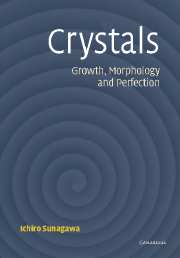Book contents
- Frontmatter
- Contents
- Foreword to the English translation
- Preface
- Part I Fundamental concepts
- Part II Application to complicated and complex systems (case studies)
- 9 Diamond
- 10 Rock-crystal (quartz)
- 11 Pyrite and calcite
- 12 Minerals formed by vapor growth
- 13 Crystals formed by metasomatism and metamorphism
- 14 Crystals formed through biological activity
- Appendixes
- Materials index
- Subject index
14 - Crystals formed through biological activity
from Part II - Application to complicated and complex systems (case studies)
Published online by Cambridge University Press: 31 October 2009
- Frontmatter
- Contents
- Foreword to the English translation
- Preface
- Part I Fundamental concepts
- Part II Application to complicated and complex systems (case studies)
- 9 Diamond
- 10 Rock-crystal (quartz)
- 11 Pyrite and calcite
- 12 Minerals formed by vapor growth
- 13 Crystals formed by metasomatism and metamorphism
- 14 Crystals formed through biological activity
- Appendixes
- Materials index
- Subject index
Summary
Various inorganic and organic crystals are formed in living bodies through the biological activity in animals and plants. Some are indispensable, such as: hydroxyapatite, which constitutes teeth and bones; aragonite and calcite, which are the main constituents of shells and exo-skeletons; and those formed through the excretion of components that are either unnecessary or due to disease. The examples given respectively show the characteristic morphology of crystals and the textures of polycrystalline aggregates. In this chapter, we will summarize and discuss which features crystal growth in inorganic systems and in living bodies have in common and which are different. To do this we will consider the morphology of the crystals.
Crystal growth in living bodies
Many inorganic and organic crystals grow in living bodies and act as indispensable major components in the function of cells and organs. Teeth and bones consist of hydroxyapatite crystals, and shells, pearls, and the exo-skeletons of coral or coccolithophores are mainly composed of carbonate crystals, such as aragonite and calcite. There are magnetite crystals of single magnetic domain in size aligned in a rosary form in cells of magnetotactic bacterium, which acts as a direction sensor. Similar magnetite rosaries are found in the brain cells of pigeons, dolphins, and salmon, and it is suggested that they act as sensors for homing, wandering, or recurring instincts.
- Type
- Chapter
- Information
- CrystalsGrowth, Morphology, & Perfection, pp. 261 - 278Publisher: Cambridge University PressPrint publication year: 2005

